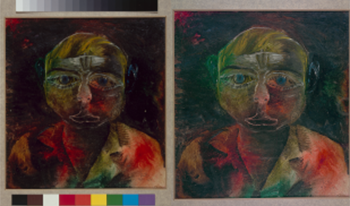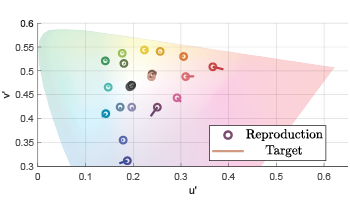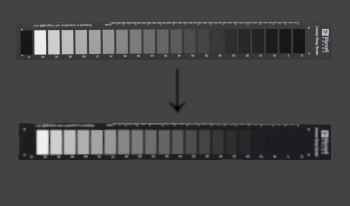
Displaying the past appearance of artworks by reversing degradation phenomena holds significant value for art historians, conservators, museum curators, educators, and the wider public, as it seeks to estimate the original artist intention. In this work, we aim to restore the past colors of a painting from documentary records done on reversal film photographs. The challenge with these photographs is that due to film-specific chromogenic processes, their colors are inaccurate with respect to the captured object. For this reason, we test the performance of four color correction methods in compensating for the color distortions inherent to each film type by using a dataset of reversal films of two color targets, X-Rite ColorChecker Digital SG and Coloraid IT-8. Furthermore, we apply the same method to detect changes due to aging and/or conservation treatments in the painting Junger Proletarier (1919) by Paul Klee, by comparing a color corrected film record from 1995 with a more recent digital capture of the painting from 2005. Our results indicate that the method which best accounts for the film chromogenic processes to reveal the actual colors of the photographed object is based on non-linear optimization using a neural network.

Virtual production stages with LED walls utilize illumination, display, and camera equipment which was not designed with this use case in mind. Because the spectral sensitivity of a camera is different from a human observer, a device specific calibration is required. Furthermore, the illumination spectrum emitted by the display contains large gaps in the cyan and yellow wavelength ranges and is dissimilar to the light sources for which cameras are designed. This causes object colors to be reproduced by the camera in an unnatural manner, making cinematographers hesitant to use LED walls as their primary light source. In this paper, a display calibration and camera color correction workflow for LED wall virtual production stages is proposed. A linear color correction matrix and the spectrum of a multi-channel LED fixture are jointly optimized to better reproduce object colors simultaneously illuminated by an LED display and the multi-channel fixture as they would appear under high CRI (Color Rendering Index) light sources. An alternative color correction method using root polynomials is found to further improve color reproduction. It is shown that the camera’s response to the display can be characterized by a linear 3×3 matrix and the display can be calibrated using the inverse of the color correction, allowing for a color accurate reproduction of a virtual environment.

The use of polarization while trying to keep the digital color reproduction accuracy at its finest is very challenging due to how polarization is interacting and affecting the light spectrum itself and due to the quality of the used polarization materials. Our study on RGB imaging and color reproduction’s fidelity with and without polarization shows that a cross circular polarization (on a camera lens and light source) will have a major impact on how a linear grayscale, whether it has a semi-glossy or matt finishing, would be reproduced in contrast to no polarization at all. A major loss in deep black shades in the case of a semi-glossy grayscale is unmistakable. In addition to a noticeable shift in both lightness and Chroma components regardless of the grayscale’s finishing but depending rather on the used color target for correction. DE00 could not paint the full picture about color fidelity despite its low conformant reported values. Whereas, a closer visual inspection of the color components separately (lightness and Chroma) reveals color reproduction problems caused by polarization.

This paper aims at presenting some problems that everyone could experience in the process of image target-based color correction (CC). We have acquired a set of images using a color checker, here we present some measures of these image before and after the color correction and we compare them with the actual values of the color checker. Comments about the results and their departures from the scene are reported together with the changes after color correction. It is shown how real scene acquisitions are subject to many issues that makes color correction process very far from the idealized colorimetric ideas.

Automotive in-cabin monitoring and surveillance imaging applications operate in the visible band during daytime and in the near infra-red band during nighttime. Utilization of the same camera for imaging in both bands is advantageous as it reduces system complexity. This work evaluates four methods for singlecamera dual-band imaging that vary by combinations between color-filter array, i.e., RGB and RGB-IR, camera filter, i.e., infrared-cut filter and dual-band filter, and processing pipeline, i.e., standard RGB and RGB-IR. We conclude that the optimal combination is RGB sensor, dual-band filter, standard color imaging pipeline, and a color correction matrix that is optimized for the visible and near-infrared bands. This method holds the net advantage of system simplicity and sufficient image quality in applications where high color accuracy is of a secondary priority.